Thursday, 15 December 2022
Jennifer Hearn, Net Zero Land Team Manager
Commitment to net zero
Net Zero Plan Stage 1: 2020-2030:
is our roadmap for how we reduce emissions by up to 50% by 2030. This is the first stage of the transition to net zero emissions by 2050.
includes emissions reduction initiatives across key sectors including energy, transport, waste, agriculture, mining and carbon finance.
Primary Industries Productivity and Abatement Program (PIPAP):
is a key element of the Net Zero Plan. Through the program, a total of $125 million is being invested by the NSW Government to ensure the prosperity of NSW’s primary industries and land sector.
will support farmers and land managers across the State to reduce their emissions, improve their carbon management, and realise other benefits such as productivity improvements, biodiversity outcomes and benefits for Aboriginal communities.
will support the sector to increase revenue by accessing environmental markets, accelerating finance for natural capital and low-carbon farming, and demonstrating environmental performance to consumers and supply chains.
Focus areas under PIPAP:
Areas 1 and 3 will focus on developing market and industry foundations and accelerating finance for natural capital and low-carbon farming.
Area 2 focuses on building a critical mass of carbon projects and building capacity, knowledge, and on-ground skills to deliver carbon projects within the sector.
The High Impact Partnerships grants sit under Focus Area 2 of PIPAP.
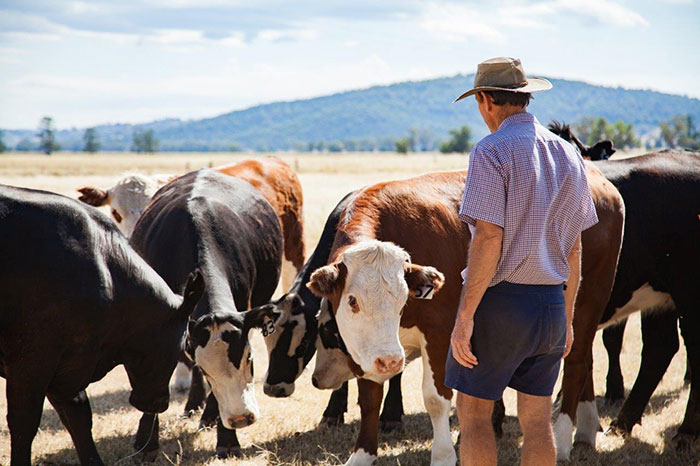
High Impact Partnerships
Round 1
Goal:
build a critical mass of carbon projects in NSW.
Scope:
agriculture emissions reduction or sequestration in soil/vegetation
immediate implementation
demonstrate co-benefits
share information and build capacity in the land sector.
Partners:
active in the agriculture or land sectors
commitment to act on climate change
will co-invest with NSW Government to deliver.
One of PIPAP’s actions involves direct investment to drive up the number of carbon projects in the land sector in NSW. We want to drive change across all land tenures in NSW, from farming to public lands to lands owned and managed by Aboriginal organisations.
The aim is to build a critical mass of carbon projects - the key outcome of this is carbon abatement, helping us work towards our net zero targets and address climate change. But we also want to increase the evidence base and on-ground examples of carbon projects, so more people understand them, are familiar with them and can see how they might fit with their business, land management or community objectives.
The main goal of the high impact partnerships is to reduce agricultural emissions or to sequester carbon in soil or vegetation on any suitable land. We want projects ready for immediate implementation that can demonstrate co-benefits and share learnings to build the capacity of land managers.
We want to partner with organisations that have an active influence in the agricultural or land sectors, are committed to acting on climate change, and are willing to co-invest with the NSW Government to deliver on those commitments.
We also want to create tangible demonstrations to help us build the capacity of the sector. This may range from short videos and factsheets delivered online, through field days and tours, to semi-permanent facilities if appropriate.
Ideally, we want land managers to have ready access to see each of the on-ground methods relevant to them.
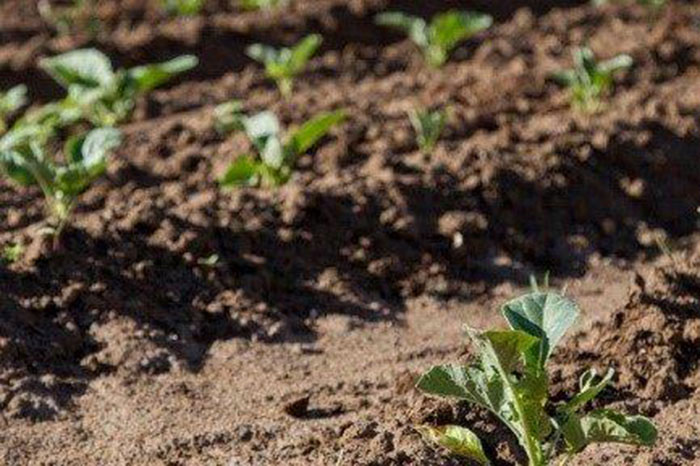
Available funding
Round 1 of the High Impact Partnerships will invest up to $10M in grant funding to support projects that can run for up to 3 years.
We will contribute between $0.5 million and $2 million per project and require the partners to co-contribute at least the same amount.
Eligibility criteria
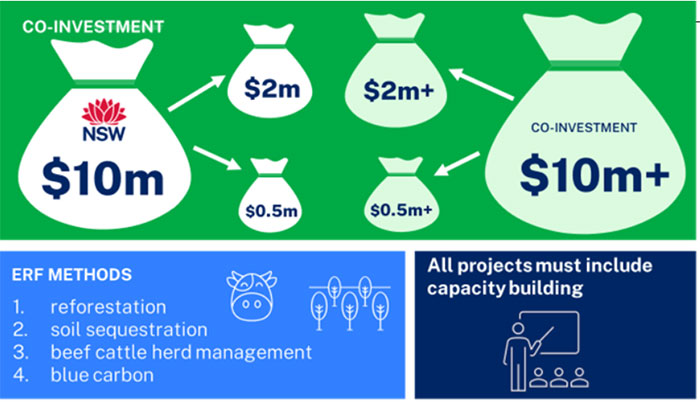
Co-investment – partners must co-invest an amount equal to or greater than the allocated grant.
Most organisations will be eligible as potential partners. However, we will not directly fund carbon service providers who operate on a for-profit basis.
All partnerships must register their carbon projects under the national emissions reduction scheme.
Partnerships will need to meet at least one of three main outcomes:
Deliver abatement at scale by registering a large number of carbon credits
Demonstrating an innovative approach to delivering carbon projects with higher economic value to land managers
Deliver co-benefits that will help encourage more uptake of carbon projects.
All projects must include capacity building
Merit criteria – check the guidelines for weighting
Diversity lens
What the grant will NOT fund:
acquiring land for a project, or infrastructure and equipment that is integral to the core business
expenditure that does not directly support the successful completion of the project
items that are business-as-usual operational costs, including business-as-usual staff costs
activities carried out or committed to before a grant is offered and accepted
projects that fund devolved grants
research projects into ERF method viability or development
This list is not comprehensive. There are limitations and exclusions associated with HIP grant funding which are outlined in the grant guidelines. We do require a detailed breakdown of budget allocation during the full application phase, and we do have the right to impose further exclusions on expenditure or ask for justification for it if we feel that it doesn’t provide benefit to NSW taxpayers. More details can be found in the grant guide found on the HIP web page.
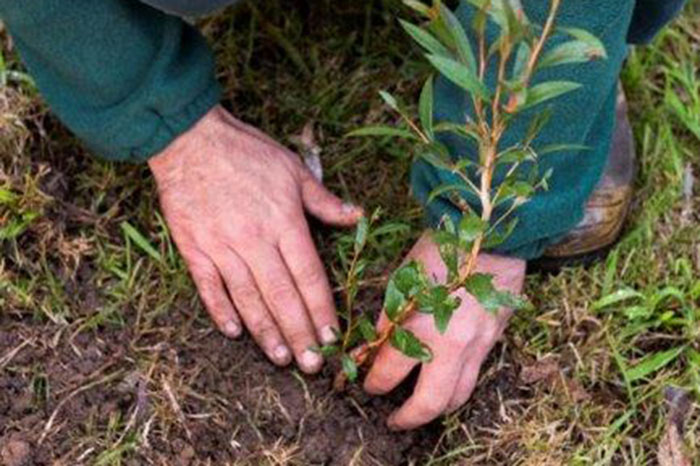
The Emissions Reduction Fund (ERF)
All applicants are required to include projects that will be registered with and administered under the ERF. This will be the formal process to register emissions reduction activities. The applicant and/or their carbon project proponents will deal directly with the CER to earn ACCUs. The NSW Government will not be involved in any aspect of the registration or ongoing management of carbon projects under that scheme. Reporting requirements for the ERF registered project and the HIP are not connected, and delivery of ERF projects will continue beyond the lifetime of the HIP.
Applicants will need to commit to a method under which to register project/s at the EOI stage.
We expect that project/s will be registered with the CER soon after the contract is awarded, although the specifics will be determined at the full application phase of grant application.
The grant project duration will be separate from projects registered through the ERF, which will be determined at the registration of the project in the chosen method.
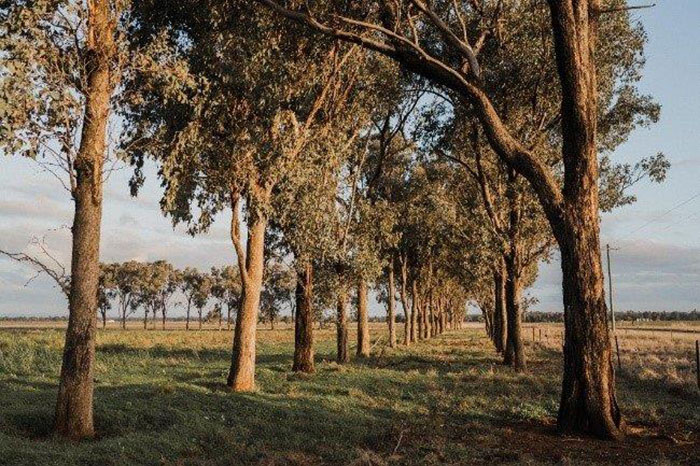
ERF methods
In Round 1 of the grant, the program focuses on 4 ERF methods, which have the potential to achieve program outcomes across a range of land management types:
Reforestation by environmental or mallee plantings: this method has significant potential for large-scale carbon sequestration and biodiversity co-benefits across large areas of NSW.
Estimation of soil organic carbon sequestration using measurement and models: this method has potential to sequester carbon while improving soil health and agricultural productivity.
Beef cattle herd management: this method can reduce carbon emissions while improving cattle health and productivity, however has had limited uptake by the 15,000 commercial beef producers in NSW.
Tidal restoration of blue carbon ecosystems: this is a new method to remove tidal barriers with potential to store carbon at higher rates than traditional vegetation methods while delivering a range of co-benefits.
Other ERF methods may be targeted in future funding rounds for High Impact Partnerships and priority project grants. This includes methods currently under review or development.
Project duration
All grant-funded components of the projects must be completed within 3 years. These will include:
preparing and registering project/s under an eligible ERF method
creating promotional material including demonstration sites for capacity-building
any other outcomes outlined by you at the full application phase.
The ERF project will be registered with and directly managed by the Clean Energy Regulator (CER) and will be delivered outside of and beyond the lifetime of our grant.
Round 1 application timeframes and process
Round 1 applications must be submitted via SmartyGrants prior to 15 February 2023. Your application will undergo an eligibility check by the Net Zero Land team, followed by a merit assessment by an independent assessment committee. We expect this process to take about 4 weeks depending on the total number of applicants that are being assessed. During this step, we may ask you to provide additional information.
Highly scored applications will progress to Phase 2, which is the full application phase. You will have a maximum of 8 weeks to complete your full application, which must also be submitted via SmartyGrants. The assessment of full applications by the independent assessment committee is expected to take around 4 weeks, after which contracts will be offered to successful applicants.
Full application stage
Successful EOI applicants will need to ensure their full applications address the following
Are there opportunities to meet additional government priorities? Are there overlaps/interactions with other initiatives? Are there additional partners that could be considered?
Is the project maximising benefits to the land manager/s?
Can the project improve its capacity-building elements?
Are there additional risks that should be considered for this project?
The PIPAP team will support applicants by providing suggestions, detailed templates in SmartyGrants for full application, and feedback from the assessment panel on strengths and weaknesses of your application.
During the full application drafting process, you will communicate with a designated support officer assigned to your application who will:
review sections of your application and provide feedback on areas that require further or clearer information or refinement
inform you of any linkages that your project will benefit from, for example through collaboration or consultation with a third party with experience and expertise in your project type
ensure that your project clearly outlines significant benefits to the end user
ensure that project risks have been determined and risk mitigation is in place.
End of year shutdown
The Office will shut down between 23 December and 9 January.
During this time, no one will be available to manage the inbox.
Any questions received over the break will be responded to after 9 January.
Stay in touch
If you haven’t yet, we highly recommend you register your interest at the bottom of the HIP web page so you can receive news and updates about future projects.
The website is www.energy.nsw.gov.au/netzeroland.
Email questions to [email protected]